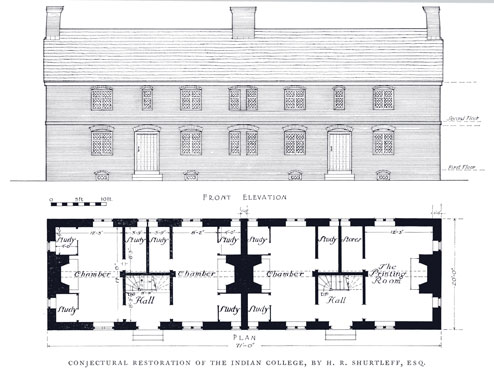Study Guide Children and Education

Table of Contents
Harvard Indian College
 A small number of students who graduated from the Indian grammar schools on Martha’s Vineyard went on to attend the “Indian College” at Harvard University. This building was in use from 1655 to 1695. Daniel Gookin described the college as follows: it was "A structure strong and substantial, though not very capacious. It cost between three and four hundred pounds. It is large enough to receive and accommodate about twenty scholars with convenient lodging and studies" (Gookin Historical Collections cited by Morison 343-44).
A small number of students who graduated from the Indian grammar schools on Martha’s Vineyard went on to attend the “Indian College” at Harvard University. This building was in use from 1655 to 1695. Daniel Gookin described the college as follows: it was "A structure strong and substantial, though not very capacious. It cost between three and four hundred pounds. It is large enough to receive and accommodate about twenty scholars with convenient lodging and studies" (Gookin Historical Collections cited by Morison 343-44).
In the 1930s, H.R. Shurtleff created a conjectural restoration of the Indian College that is deemed accurate and shown at right (Floyd 13). Sadly the college was perhaps too impressive, as it was not used very long for Indian students but instead was quickly appropriated for English students. Famous Algonquian students who attended included John Sassamon, as well as two Wampanoags from Martha’s Vineyard: Caleb Cheeshahteaumuck (A.B. 1665), and Joel Iacoomis. Cheeshahteaumuck was the first American Indian to graduate from Harvard College. All three of these early students met untimely deaths: Sassamon’s murder helped instigate King Philip’s War, Cheeshahteamuck died of consumption shortly after graduation, and Iacoomis was drowned on a voyage home (Morison 352-56). The deaths of the youths from Martha’s Vineyard were recorded in the Records of the New England Company (1665) excerpted in the archive.
For the students who attended the Indian College, it must have been an exciting place. In addition to educating Algonquians for future missionary activities, the Indian College housed a press, which published New England best sellers like the “Day of Doom” (1662) and Cotton’s “Spiritual Milk for Babes” (Morison 350). The press also printed many of the early Algonquian books used on Martha’s Vineyard, including the Eliot Bible. James Printer, an Algonquian, helped man the press and played an important role in the fifteen Indian language documents the press created (Morison 349). In May of 1997, Harvard erected a plaque to Cheeshahteaumuck and his classmates (“John Harvard’s Journal Commencement 1997").
Items Related to Harvard Indian College in the Archive
The Schoolhouse < Previous | Next > Wheelock’s Indian School